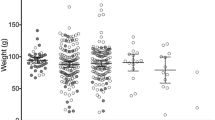Abstract
Production of doubled haploids via mitotic gynogenesis is a useful tool for the creation of completely inbred fish. In order to produce viable doubled haploid channel catfish, we utilized hydrostatic pressure or thermal treatments on eggs fertilized with sperm that had been exposed to ultraviolet light. At 1.5 h post-fertilization, the embryos were exposed to either 590 kg/cm2 hydrostatic pressure for 3 min, 37°C for 5 min, or 41°C for 3 min. In the pressure-treated group, only 21 offspring hatched from five spawns with family sizes of one, two, two, four, and 12 offspring each. Eight embryos from the 37°C treatment and 32 embryos from the 41°C treatment survived to hatch. Genotype analysis using microsatellite loci demonstrated all 21 offspring resulting from pressure treatment were homozygous at the 64 loci tested, and none contained alleles unique to the donor male. Eleven of 32 offspring from the 41°C treatment were homozygous at the 18 loci tested, while 21 offspring were heterozygous at six to 12 of these loci. Again, no offspring contained alleles unique to the donor male. However, all eight offspring from the 37°C treatment were heterozygous at multiple loci, and one contained unambiguous paternal alleles. These experiments demonstrated our ability to produce viable homozygous, doubled haploid channel catfish. Doubled haploid catfish can be used to create completely inbred populations for genetic analyses, and homozygous genomic templates will be useful in gene identification and genome characterization.
Similar content being viewed by others
References
Arai K (2001) Genetic improvement of aquaculture finfish species by chromosome manipulation techniques in Japan. Aquaculture 197:205–228
Bidwell CA, Chrisman CL, Libey GS (1985) Polyploidy induced by heat shock in channel catfish. Aquaculture 51:25–32
Bongers ABJ, Bovenhuis H, Van Stokkom AC, Wiegertjes GF, Zandieh-Doulabi B, Komen J, Richter CJJ (1997) Distribution of genetic variance in gynogenetic or androgenetic families. Aquaculture 153:225–238
Dunham RA (2004) Aquaculture and fisheries biotechnology: genetic approaches. CABI, Cambridge
Felip A, Zanuy S, Carrillo M, Piferrer F (2001) Induction of triploidy and gynogenesis in teleost fish with emphasis on marine species. Genetica 111:175–195
Goudie CA, Simco BA, Davis KB, Liu Q (1995) Production of gynogenetic and polyploid catfish by pressure-induced chromosome set manipulation. Aquaculture 133:185–198
Jenneckens I, Muller-Belecke A, Horstgen-Schwark G, Meyer JN (1999) Proof of the successful development of nile tilapia (Oreochromis niloticus) clones by DNA fingerprinting. Aquaculture 173:377–388
Komen H, Thorgaard GH (2007) Androgenesis, gynogenesis and the production of clones in fishes: a review. Aquaculture 269:150–173
Komen J, Bongers ABJ, Richter CJJ, van Muiswinkel WB, Huisman EA (1991) Gynogenesis in common carp (Cyprinus carpio L.). II. The production of homozygous gynogenetic clones and F1 hybrids. Aquaculture 92:127–142
Martinez VA, Hill WG, Knott SA (2002) On the use of double haploids for detecting QTL in outbred populations. Heredity 88:423–431
Masser M, Dunham R (1998) Production of hybrid catfish. Southern Regional Aquaculture Center, Stoneville Publication Number 190 (http://www.aquanic.org/publicat/usda_rac/efs/srac/190fs.pdf)
Nam YK, Cho YS, Kim DS (2000) Isogenic transgenic homozygous fish induced by artificial parthenogenesis. Transgenic Res 9:463–469
Nam YK, Choi GC, Kim DS (2004) An efficient method for blocking the 1st mitotic cleavage of fish zygote using combined thermal treatment, exemplified by mud loach (Misgurnus mizolepis). Theriogenology 61:933–945
Purdom CE, Thompson D, Lou YD (1985) Genetic engineering in rainbow trout, Salmo gairdnerii Richardson, by the suppression of meiotic and mitotic metaphase. J Fish Biol 27:73–79
Streisinger G, Walker C, Dower N (1981) Production of clones of homozygous diploid zebra fish (Brachydanio rerio). Nature 291:293–296
Tanck MWT, Claes T, Bovenhuis H, Komen J (2002) Exploring the genetic background of stress using isogenic progenies of common carp selected for high or low stress-related cortisol response. Aquaculture 204:419–434
Taniguchi N, Yamasaki M, Takagi M, Tsujimura A (1996) Genetic and environmental variances of body size and morphological traits in communally reared clonal lines from gynogenetic diploid ayu, Plecoglossus altivelis. Aquaculture 140:333–341
USDA (2009a) Catfish production. Agricultural Statistics Board, US Department of Agriculture, National Agricultural Statistics Service , Washington, D.C. (http://usda.mannlib.cornell.edu/usda/current/CatfProd/CatfProd-01-30-2009_revision.pdf)
USDA (2009b) Catfish processing. Agricultural Statistics Board, US Department of Agriculture, National Agricultural Statistics Service, Washington, D.C. (http://usda.mannlib.cornell.edu/usda/current/CatfProc/CatfProc-01-21-2009.pdf)
Waldbieser GC, Quiniou SMA, Karsi A (2003) Rapid development of gene-tagged microsatellite markers from bacterial artificial chromosome clones using anchored TAA repeat primers. BioTechniques 35:976–979
Zhang X, Onozato H (2004) Hydrostatic pressure treatment during the first mitosis does not suppress the first cleavage but the second one. Aquaculture 240:101–113
Zhang X, Asami T, Onozato H (2007) Polypolar spindle formation during first cell cycle in rainbow trout oncorhynchus mykiss embryos after heat-shock treatment. Fish Sci 73:1325–1331
Zimmerman AM, Evenhuis JP, Thorgaard GH, Ristow SS (2004) A single major chromosomal region controls natural killer cell-like activity in rainbow trout. Immunogenetics 55:825–835
Acknowledgements
The authors thank Mona Kirby and Myrtis Ford-Bailey for technical assistance. Mention of trade names or commercial products in this publication is solely for the purpose of providing specific information and does not imply recommendation or endorsement by the US Department of Agriculture.
Author information
Authors and Affiliations
Corresponding author
Electronic Supplementary Materials
Below is the link to the electronic supplementary material.
ESM Table 1
Microsatellite loci used for genotype analysis of doubled haploid catfish. Fluorophore is denoted at beginning of forward primer (DOC 33 kb)
ESM Table 2
Genotypes of gynogenetic fish produced by pressure treatment of activated catfish eggs. Only one allele is displayed in homozygous fish (DOC 358 kb)
ESM Table 3
Genotypes of gynogenetic fish produced by 37°C—5 min treatment of activated catfish eggs. Only one allele is displayed in homozygous fish (DOC 49 kb)
ESM Table 4
Genotypes of gynogenetic fish produced by 41°C—3 min treatment of activated catfish eggs. Only one allele is displayed in homozygous fish (DOC 135 kb)
Rights and permissions
About this article
Cite this article
Waldbieser, G.C., Bosworth, B.G. & Quiniou, S.M.A. Production of Viable Homozygous, Doubled Haploid Channel Catfish (Ictalurus punctatus). Mar Biotechnol 12, 380–385 (2010). https://doi.org/10.1007/s10126-009-9221-2
Received:
Accepted:
Published:
Issue Date:
DOI: https://doi.org/10.1007/s10126-009-9221-2




